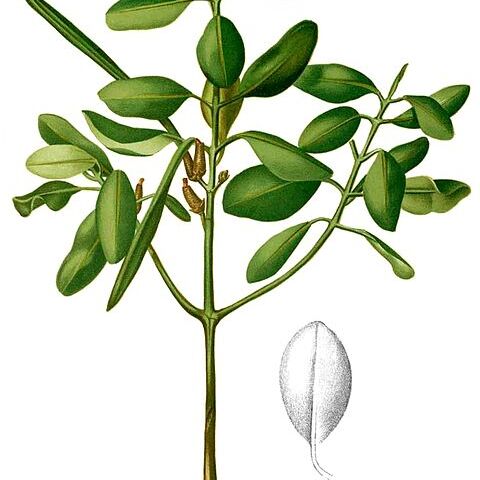Small or medium-sized trees or shrubs of muddy sea-shores and estuaries; bark grey-brown. Roots and lower part of trunk forming a ± pyramidal base. Aerial roots present as upright projections from the mud. Leaves evergreen, opposite, petiolate, entire, leathery and glabrous. Inflorescences cymose, shortly pedunculate; bracteoles paired and persistent. Calyx connate below; tube adnate to the ovary; lobes 5 (–6), persistent and spreading in fruit. Petals 5 (–6), membranous, appendaged. Stamens 10 (–12), inserted on the epigynous disc; anthers dehiscing longitudinally, introrse. Ovary inferior, 3-loculate; style thickened below; stigma minutely 3-fid. Fruit a leathery berry, all but one seed usually aborting. Seed viviparous. Embryo falling by separation from the cotyledons, leaving the fruit on the tree.
Shrubs or small trees, often with stilt roots clustered around base of trunk; knee roots present or absent. Leaves crowded near tips of shoots, entire; veins obscure on both surfaces. Inflorescence usually 4-to many-flowered; bracteoles connate at base. Sepals usually 5, ovate, acuminate. Petals as many as sepals, free or cohering at base by marginal hairs, involute. Stamens usually 10, in unequal pairs opposite petals and enclosed by inrolling of petal margins; anthers 4-locular. Ovary half-inferior, 3-locular; style simple; stigma simple or obscurely lobed. Fruit elongating above rim of hypanthium. Seeds viviparous. Hypocotyl of propagule narrowly club-shaped, terete or ridged.
Shrubs or small trees. Trunks often with stilt roots clustered around base. Stipules lanceolate. Leaves crowded near shoot apex; leaf blade veins obscure on both surfaces. Inflorescences condensed cymes, pedunculate, 2-to many flowered. Bracteoles 2, partly connate. Calyx deeply 5-or 6-lobed. Petals 5 or 6, white, each embracing 2 stamens, cohering at base, margin with uncinate trichomes. Stamens twice as many as calyx lobes. Disk cupular, shallowly lobed. Ovary semi-inferior, 3-loculed; ovules 2 per locule; style short; stigma entire or shortly lobed. Fruit ovoid. Hypocotyl clavate, ridged and grooved, apically tapering.
Fruit an ovoid, leathery, indehiscent, unilocular, usually 1-seeded berry, mostly superior; seed germinating on the plant, the radicle developing a clavate, ridged and sulcate hypocotyl tapering to the apex, which perforates the apex of the fruit and falls out of it.
Wholly glabrous evergreen shrubs or medium-sized trees of muddy sea-shores and estuaries; stems with appressed stilt-roots, forming, with the lower part of the trunk, a ± pyramidal base; pneumatophores present as upright projections from the mud.
Petals emarginate or truncate, fringed or with (2)3 long-stipitate clavate glands above, sometimes cohering from the middle towards the base by the uncinate-hairy margins, inserted at the mouth of the calyx-tube, each embracing 2 stamens.
Leaves decussate, crowded at the apex of the twigs, petiolate, stipulate; leaf-lamina entire, leathery, with the nerves obscure on both faces.
Ovary semi-inferior, 3-locular, each locule 2-ovulate; style simple, terete and conical below, minutely 2–3-lobed to entire at the apex.
Stamens twice as many as the petals, inserted in the sinuses of the disk; filaments unequal to ± equal in each pair; anthers ± ovoid.
Flowers bisexual, subsessile to sessile, with cupular, partly connate pairs of bracts disposed beneath each flower and each cluster.
Inflorescences (2)4–8(10)-flowered, cymose, condensed, solitary, axillary, towards the upper part of the branches.
Calyx glabrous, persistent; calyx-tube adnate to the ovary; calyx-lobes (4)5(6), spreading in fruit.
Disk shallowly (8)10(12)-lobed, cupuliform.

